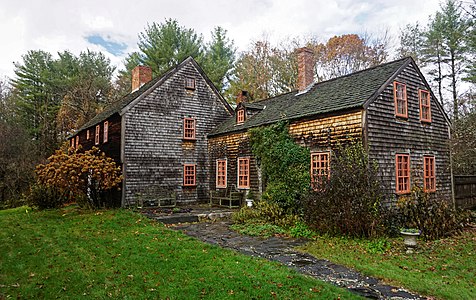The Dickinson–Pillsbury–Witham House is a historic First Period house which, along with an 18th-century barn, sits on an 8.84 acre lot in Georgetown, Massachusetts. The well-preserved building with its massive original hardwood frame has many surviving early components, including a rare original enclosed stairway, doors, wooden latches, hardware, cupboards, brick nogging in the walls, and early paint.
Dickinson–Pillsbury–Witham House | |
 An early photo of the Dickinson–Pillsbury–Witham House | |
| Location | 170 Jewett Street, Georgetown, Massachusetts |
|---|---|
| Coordinates | 42°43′44.04″N 70°56′42″W / 42.7289000°N 70.94500°W |
| Built | c. 1700 |
| Architectural style | First Period, Colonial |
| MPS | First Period Buildings of Eastern Massachusetts TR |
| NRHP reference No. | 90000210 [1] |
| Added to NRHP | March 9, 1990 |
The house was the original home of the Georgetown Historical Society. The Society moved to the Brocklebank–Nelson–Beecher House in 1975 and sold the Dickinson–Pillsbury–Witham House to an archaeologist, who took meticulous care of the property for over 40 years. During that time the building was surveyed by architectural historian and genealogist Abbott Lowell Cummings.
The oldest part of the 2+1⁄2-story wood-frame colonial house was built c. 1700[2] by James Dickinson, and consisted of the chimney and rooms to its right. The left side rooms are also First Period, apparently built soon afterward, based on similar construction methods used on the two sections. In 1856 a knee-wall cape was moved to the lot and attached as an ell on the right-hand side against the oldest end of the dwelling.
In addition to historical integrity, the house is notable for being the home of War of 1812 veteran and inventor Paul Pillsbury, who purchased the property about 1801. His inventions included devices for pegging shoes, milling bark off tree sections, and stripping kernels from ears of corn.[3] Paul Pillsbury and his wife Elisabeth Frink had a family of seven sons and one daughter. Elisabeth died in 1829 at age 41. Pillsbury remarried in 1843 to Sarah Andrews Pike, the widow of Benjamin Pike and mother of CSA Brigadier-General Albert Pike. Paul Pillsbury was also the uncle of abolitionist Parker Pillsbury[4] and the great-uncle of attorney Albert E. Pillsbury who drafted the bylaws of the NAACP.
The house was listed on the National Register of Historic Places in 1990.[1]
-
The Dickinson–Pillsbury–Witham House
-
Dickinson House with Pillsbury 1856 knee-wall cape addition
See also edit
References edit
- ^ a b "National Register Information System". National Register of Historic Places. National Park Service. April 15, 2008.
- ^ "Massachusetts Historical Commission Architectural History Report". Massachusetts Historical Commission - MACRIS.
- ^ "NRHP nomination for Dickinson-Pillsbury-Witham House". Commonwealth of Massachusetts. Retrieved 2014-01-14.
- ^ Hamilton, Duane (1888). History of Essex County, Massachusetts. Philadelphia, J. W. Lewis & Co.



